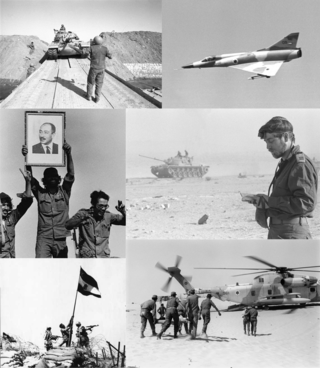
The Yom Kippur War, also known as the Ramadan War, the October War, the 1973 Arab–Israeli War, or the Fourth Arab–Israeli War, was fought from 6 to 25 October 1973 between Israel and a coalition of Arab states led by Egypt and Syria. Most of the fighting occurred in the Sinai Peninsula and Golan Heights, territories occupied by Israel in 1967. Some combat also took place in Egypt and northern Israel. Egypt aimed to secure a foothold on the eastern bank of the Suez Canal and use it to negotiate the return of the Sinai Peninsula.
The history of the Israel Defense Forces (IDF) intertwines in its early stages with history of the Haganah.

The 1st "Golani" Brigade is an Israeli military infantry brigade. It is subordinated to the 36th Division and traditionally associated with the Northern Command. It is one of the five infantry brigades of the regular Israel Defense Forces (IDF), the others being the Paratroopers Brigade, the Nahal Brigade, the Givati Brigade and the Kfir Brigade. Its symbol is a green olive tree against a yellow background, with its soldiers wearing a brown beret. It is one of the most highly decorated infantry units in the IDF. The brigade consists of five battalions, including two which it kept from its inception, one transferred from the Givati Brigade (51st).
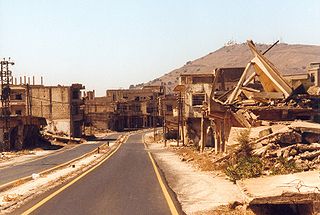
Quneitra is the largely destroyed and abandoned capital of the Quneitra Governorate in south-western Syria. It is situated in a high valley in the Golan Heights at 1,010 metres (3,313 feet) above sea level. Since 1974, pursuant to United Nations Security Council Resolution 350 and the Agreement on Disengagement between Israel and Syria, the city is inside the UN-patrolled buffer zone.

The Purple Line was the ceasefire line between Israel and Syria after the 1967 Six-Day War which serves as the de facto border between the two countries. In 2024 following the fall of Ba'athist Syria, Israel broke the Purple Line during its invasion of Syria.

The United Nations Disengagement Observer Force (UNDOF) is a United Nations peacekeeping mission tasked with maintaining the ceasefire between Israel and Syria in the aftermath of the 1973 Yom Kippur War. The mission was established by United Nations Security Council Resolution 350 on 31 May 1974, to implement Resolution 338 (1973) which called for an immediate ceasefire and implementation of United Nations Security Council Resolution 242.

Quneitra Governorate is one of the fourteen governorates (provinces) of Syria. It is situated in southern Syria, notable for the location of the Golan Heights. The governorate borders the countries of Lebanon, Jordan and Israel, and the Syrian governorates of Daraa and Rif Dimashq. Its area varies, according to different sources, from 685 km2 to 1,861 km2. The governorate had a population of 87,000 at the 2010 estimate. The nominal capital is the now abandoned city of Quneitra, destroyed by Israel before their withdrawal in June 1974 in the aftermath of the Yom Kippur War; since 1986, the de facto capital is Madinat al-Salam.
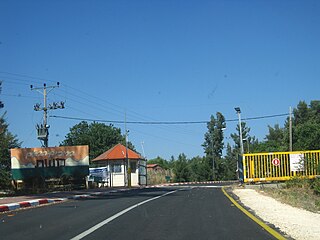
Keshet is an Israeli settlement in the Golan Heights, organized as a moshav shitufi. It was established in 1974 after the Yom Kippur War by young activists near the Syrian city of Quneitra, which had been occupied and subsequently razed to the ground in the Six-Day War. Its name is a translation of the name Quneitra ("arch"). In 2022 it had a population of 878.
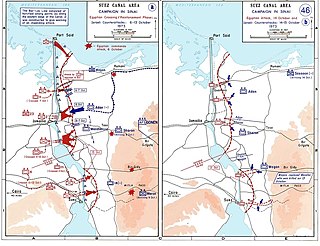
The Battle of the Sinai was one of the most consequential battles of the Yom Kippur war. An Egyptian attacking force that advanced beyond their line of defense at the Bar-Lev Line was repulsed with heavy losses by Israeli forces. This prompted the Israelis to launch Operation Abiray-Lev the next day, penetrating the Egyptian line of defense and crossing the Suez Canal.

Israel–Syria relations refer to the bilateral ties between the State of Israel and the Syrian Arab Republic. The two countries have been locked in a perpetual war since the establishment of Israel in 1948, with their most significant and direct armed engagements being in the First Arab–Israeli War in 1948–1949, the Third Arab–Israeli War in 1967, and the Fourth Arab–Israeli War in 1973. Additionally, Israeli and Syrian forces also saw relatively extensive combat against each other during the Lebanese Civil War, the 1982 Lebanon War, as well as the War of Attrition. Both states have at times signed and held armistice agreements, although all efforts to achieve complete peace have been without success. Syria has never recognized Israel as a legitimate state and does not accept Israeli passports as legally valid for entry into Syrian territory; Israel likewise regards Syria as a hostile state and generally prohibits its citizens from travelling there, with some exceptions and special accommodations being made by both countries for Druze people residing in Syria and the Golan Heights. Israel and Syria have never established formal diplomatic relations since the inception of both countries in the mid-20th century.

The 5th Mechanized Division was a mechanized infantry division of the Syrian Arab Army. The division waspart of the Syrian Army's 1st Corps.
The 2012–2014 Quneitra Governorate clashes began in early November 2012, when the Syrian Army began engaging with rebels in several towns and villages of the Quneitra Governorate. The clashes quickly intensified and spilled into the UN-supervised neutral demilitarized zone between Syrian controlled territory and the Israeli-occupied Golan Heights.

The 1st Armoured Division was an armored division of the Syrian Arab Army. It was established in 1970 and was part of the 2nd Corps. The 1st Division was the largest formation of the Syrian Arab Army.
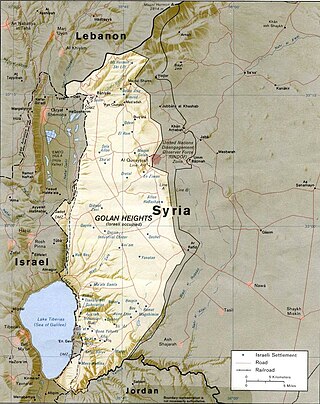
The Agreement on Disengagement between Israel and Syria, which was signed on May 31, 1974, provided for the continuation of the cease-fire already in effect and for the separation of opposing parties by a UN Peacekeeping Force. The Agreement specifically states that “H. This agreement is not a peace agreement. It is a step toward a just and durable peace on the basis of Security Council Resolution 338 dated October 22, 1973.”

The 3rd Armoured Division was a formation of the Syrian Army responsible for securing the northern approach to Damascus. The division is based in a military complex near Qutayfah and has traditionally been seen as one of the Syrian Armed Force's most reliable conventional divisions. The division is part of the 3rd Corps.

This article deals with the history and development of tanks of the Israeli Army, from their first use after World War II in the establishment of the State of Israel after the end of the British Mandate, and into the Cold War and what today is considered the modern era.

The Beit Jinn offensive was a military operation by the Syrian Arab Army against opposition groups in the Western Ghouta area, starting on 28 November 2017.

The War of Attrition in the Bashan Salient was an armed conflict between Israel and Syria in the Bashan Salient from March through May 1974. The region was conquered by the Israeli army (IDF) at the end of the Yom Kippur War in October 1973, and held by Israeli forces until the signing of the disengagement agreement on May 31, 1974, that saw the evacuation of all Israeli forces and the Bashan Salient returned to Syria.

On 8 December 2024, Israel invaded the buffer zone between Syria and the Israeli-occupied Golan Heights, and carried out an aerial campaign targeting the Syrian Army's military capabilities, following the fall of the Assad regime.

















